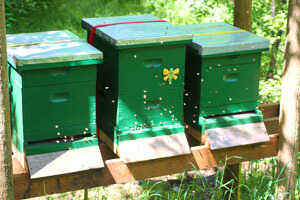
After months of study, you finally take the plunge and buy your very first wooden hive. You sand the sweet-smelling boards until they feel like silk beneath your fingers. You browse the paint aisle of your local home improvement store and spend far too much money, buying colors that spark your imagination, colors with names like Peony, Key Lime, or Meyer Lemon. Once it’s complete, you place your gleaming hive on the lovingly built stand and install your first colony. Everything is perfect until your mentor says you really should have two hives, just in case you need some brood or want to raise a queen.
The two-is-better-than-one advice from experienced beekeepers makes sense, so you buy another hive, another colony, and repeat the entire process. Now your setup is to die for. In fact, you revel in your flawless apiary until the moment you realize your bees are about to swarm. Quickly you buy two more hives. You decide they really don’t need sanding, so you just paint them to match the others. Just in time, too. You manage to catch the first swarm and split the second colony proactively. You’re already up to four colonies in your very first year!
In a few days, you notice that the swarm trap hanging in your old maple tree is attracting a lot of attention. You run right out and buy a fifth hive just in case, slap on a coat of partially congealed paint, and balance the hive on some cinder blocks. Just in time again. Your trap enticed a swarm on the run, so now you’re up to five.
Bees Happen
We constantly read the bad news. Headlines remind us that honey bee Armageddon is just around the corner, and we try to stay apprised of the burgeoning panoply of new threats. We read anxiously about each novel combatant poised to take down our bees. We attend lectures and classes, surf the net, and buy books, forever trying to prepare for the next assault.
But despite the naysayers, bees happen. No matter how you try to control the number of hives, it continues to multiply. We watch our little backyard apiaries expand, regardless of the news. Those who promised their partners “just a hive two” to pollinate the vegetable garden and make a little honey for the family find themselves with more hives per acre than a California almond orchard.
When our backyards become overly intimidating, when we begin wearing veils to take out the trash, we seek friends and family who might be willing to park a hive on their property. We promise them honey and they agree. As soon as we can buy a pickup, we deliver a hive or perhaps two — if they said yes to one, certainly they wouldn’t mind two — to their homes. Now we have an outyard! How cool is that?
Does it stop there? Of course not. It never stops. In fact, it gets completely out of hand before we realize what’s happening. Like the delicately swaddled infant that morphs into an insolent teenager, the tiny backyard apiary evolves into an albatross, hindering our every move. It requires monitoring, maintenance, surveillance, healthcare, equipment, and heaps of dollar bills. Days off are spent not with the family but with bees, vacations are scheduled around swarm season, and the retirement nest egg is raided for mite meds and electronic monitoring devices that can measure everything from colony weight and humidity to sound and temperature.
Outgrowing Reason
Most of us have been there. Like so many others, I began beekeeping with one hive and quickly added a second. At that point, I coerced my engineer husband into building the hive stand of my dreams, a structure that holds my hives 18 inches off the ground and includes a roof to protect them from some of our heavy Northwest rainfall. It’s anchored in the ground with concrete and capable of holding a couple thousand pounds. The best feature was it could accommodate three hives — if for some reason I ever got that many — with three hive perches bolted to the stand itself so they couldn’t slide off. It was a dream come true.
My built-in hive stand was a showpiece — greatly admired by my ….


